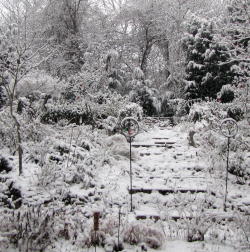.jpg) This brings to an end the series of posts about the color black in the garden. Yea! or Boo!, depending on your own feelings about multiple posts on the same exact topic. Personally, my emotions are mixed, tiring of writing about the same thing four times, but juiced about the thought of the new black garden and all that is possible within that theme. There are so many more plants with dark hued leaves, flowers or that have black in the name growing here, and planned, just no publish worthy photos of them in the files. 2008 promises to be an improved year for pictures of the garden. A new camera, the Canon A720 IS has just been added to the technical library. It needs some practice and some actual blooming plants to make this year the year of the meaningful shot. Only starting the blog December 7 of last year, pictures up until then were for personal record keeping only. It was nice to browse the archives during winter to dream, plan and feel the power of the plants, but a new purpose has emerged, The Blog. Enough rambling.
This brings to an end the series of posts about the color black in the garden. Yea! or Boo!, depending on your own feelings about multiple posts on the same exact topic. Personally, my emotions are mixed, tiring of writing about the same thing four times, but juiced about the thought of the new black garden and all that is possible within that theme. There are so many more plants with dark hued leaves, flowers or that have black in the name growing here, and planned, just no publish worthy photos of them in the files. 2008 promises to be an improved year for pictures of the garden. A new camera, the Canon A720 IS has just been added to the technical library. It needs some practice and some actual blooming plants to make this year the year of the meaningful shot. Only starting the blog December 7 of last year, pictures up until then were for personal record keeping only. It was nice to browse the archives during winter to dream, plan and feel the power of the plants, but a new purpose has emerged, The Blog. Enough rambling..jpg) Columbine , aquilegia ‘Magpie’, another seed grown success that has shown itself to be true to seed , the babies have the dark hood and white center so charming in the shade garden. Several other varieties of columbine seeds were sprinkled around this bed last summer, it is hoped some of them nestled into the soil in an effort to send out a root and begin life.
Columbine , aquilegia ‘Magpie’, another seed grown success that has shown itself to be true to seed , the babies have the dark hood and white center so charming in the shade garden. Several other varieties of columbine seeds were sprinkled around this bed last summer, it is hoped some of them nestled into the soil in an effort to send out a root and begin life.
Azalea, R. ‘Mother’s Day’, bears dark pink blossoms, but they unfurl earlier than mother’s day here in TN. The leaves will turn dark green as the temperatures rise. Again, the dusky foliage nearly blends in with the leaf litter.
.jpg) Another of the backbone plants here, penstemon’ Husker Red’ can be found in nearly every bed as it seeds about abundantly. The dark foliage is evergreen, or everpurple actually, and is a wonderful foil to the bright blooms of these exbury azaleas, R.’Crimson Tide’ and R. ‘Primrose’. It is hoped that readers of this blog will be in for a rare treat when the large collection of deciduous azaleas planted in Faire Garden open their flowers this spring. Mucho dinero has been spent aquiring different cultivars of this favorite shrub. It might be possible to get a shot of the entire population for a group photo in addition to the single portraits. Last year the late freeze stopped the opening buds dead in their tracks, a sea of brown and a big disappointment resulted. Sheets from the thrift store will be at the ready to cover the delicate jewels should such an event occur again.
Another of the backbone plants here, penstemon’ Husker Red’ can be found in nearly every bed as it seeds about abundantly. The dark foliage is evergreen, or everpurple actually, and is a wonderful foil to the bright blooms of these exbury azaleas, R.’Crimson Tide’ and R. ‘Primrose’. It is hoped that readers of this blog will be in for a rare treat when the large collection of deciduous azaleas planted in Faire Garden open their flowers this spring. Mucho dinero has been spent aquiring different cultivars of this favorite shrub. It might be possible to get a shot of the entire population for a group photo in addition to the single portraits. Last year the late freeze stopped the opening buds dead in their tracks, a sea of brown and a big disappointment resulted. Sheets from the thrift store will be at the ready to cover the delicate jewels should such an event occur again.
.jpg)
One of the blackest of the black, besides the mondo grass is the sweet william ‘Sooty’, dianthus barbatus, ‘Sooty’. This was grown from Thompson and Morgan seeds several years ago and has self sown obligingly. It almost disappears by itself with the foliage as dark as the bloom, but contrasts nicely with a bicolor sweet william in the same area.
.jpg)
The same D. ‘Sooty’ in brighter light. Against the fence post is rosa ‘Cadenza’, shown in part one of this series of posts. A very sunny spot, both the rose and the sweet william flower profusely here. Not visible in the photo, the Sooty is planted in an old rusty wheelbarrow sitting next to the chain link fence. That explains the height of what is a normally twelve to eighteen inch plant.
Bergenia ‘Bressingham Ruby’, new to the garden, planted in late summer last year, holds great promise. It was chosen for the winter leaf interest, but the pink blooms are said to enhance the spring blooming bulbs. The yellow flowers of the nearby emerging daffodils in a duet with the bergenia, will delight the viewer, sitting happily in the addition, in the rocking recliner, sipping a warm beverage, looking out at the early spring festival which is soon to come.
Most of the concrete poured after our arrival at this abode has been imbedded with black river rock. All of the step stones we made ourselves have the corners sprinkled with the black pebbles. The professionally finished sidewalks and driveway had some of these same stones pushed in when the back of the workman was turned. This photo shows the step out to the gravel path from the covered vestibule at the back of the house. In the center, now tarnished but once shiny, is a Sacajawea dollar coin dated 2000, to mark the date of the transformation of this property from college party central to Faire Garden.
.jpg)
After seeing all these dark colors, a flash of sunshine is needed to help refocus those eyeballs. The black connection can be explained with the common name, black eyed susan, rudbeckia hirta.
.jpg)
Dahlia ‘Bishop’s Children’ seeds were ordered several years ago and have over wintered with only a few losses. More seeds were ordered from Thompson and Morgan again this winter to try and increase their numbers. In addition, seeds were saved from existin plants and have also been sown. Even one surviving seedling would be considered a huge success from those saved. The purchased seeds germinate fairly easily.
.jpg)
As you can see above, Faire Garden is an organic garden. Some flowers are more eaten up than others. Someone, a caterpillar, grasshopper, seventeen year locust, who knows, thouth that this maroon dahlia ‘Bishop’s Children’ was tasty indeed. We are still trying for the yellow flower of this variety shown in the picture in the catalog and on the seed packet along with the reds, oranges and wine hued types. Plants were purchased from White Flower Farm with yellow blooms, dahlia ‘Happy Single Party’, to ensure that color be present in the dahlia farm area, but the challenge is to get one from seed. Maybe this will be the year for that. Maybe this will be the year for many many happy surprises in Faire Garden.
The sweetest black of all, after Hazel, is the approach of rain clouds in the sky. Standing in the knot garden, looking out over the metal roof of the main house, a good view of the northern horizon lets us see the oncoming weather systems. We are still in desperate need of major rain to fill the reservoirs and quench the thirst of the trees and shrubs to keep our ecosystem healthy and happy. So far there has been occasional rain here this year. May the black clouds grace our garden and everyone’s still in need of water replenishment many, many more times.









very nice installment of color in the garden. i tried to go back and pick my favorite picture, but i couldn’t decide (although rosa cadenza would definitly be in the top two). there may be a few more darker additions to the brokenbeat garden this year now…thanks fg 😉
i felt it appropriate to listen to black metal while reading your final black in the garden post. it’s not often one has the opportunity to headbang while looking at flowers. for some reason people have thought that the two don’t seem to work together. trust me, they do. and that’s why i’m here; to call question to all things perceived normal, to dismantle. that’s what i feel you are doing by chosing black as your preferred color in the garden. way to shake it up, frances. now all you need is some metal….
brokenbeat…thanks but I prefer the music of the birds singing when in the garden, or maybe Joanna Newsome while looking at photos and reading of gardens and gardening. Sorry to disappoint you.love.
mashley..No need to pick favorites in the garden world, it’s just not possible, for me anyway, to say one is better, prettier, anythinger than another. It is a safe bet that you will see more black in your garden, however!love.
Frances, I never would have thought that black would be so pretty in the garden. This has been a very interesting series. I can’t wait to see the beautiful pictures you take this year with your new camera.
Robin’s nesting place…thanks. I am open to all suggestions about taking photos with the new camera!
I do like all of those black hued flowers Frances. They have given me some ideas. I have had a few of these annuals (annuals when grown here) you have shown.
Berginia is a plant I have had trouble establishing here. I think I won’t try it again and then I see what you have growing and I want to try again.
Lisa…There is always room for black in the garden, even just a coleus or two. We shall see how the bergenia pans out, it is on the hill, that may be too dry for it. A local nursery had it displayed prominently so it got to come home with me. It has looked good over the winter , so far anyway.
This has been an enjoyable & educational series of posts. I’m drawn to dark plants, but have struggled with how to best place them in the garden. Thanks for some inspiration. I ordered a Dahlia from the Bishop series, the ill-named Bishop of Canterbury. I hope it will look as good as yours (pre-chewed).
MMD…Thanks. Those Bishop series dahlias have grown well here. I think the ‘children’ came from the Bishop of Llandaff. The dahlias are not babied here, no feeding, no staking, no extra water, so they have to be tough.
The black-eyed susan’s really stand out as you scroll through the pictures. I remember going to pick those with you in a field in Berwick.
chickenpoet…Yes, so do I. We had that area behind the subdivision that was loaded with wild flowers, a pleasant memory.
Well, first, I just had to smile at your anticipation about filling “The Blog”—with a capital T. Indeed! I’ve found that the blog quickly becomes The Blog, and it Must. Be. Fed. as it gets very hungry. Now and then I have to step away from mine or risk feeling like a mother bird with a cuckoo usurper in the nest. 🙂
However, I don’t want you to step away from your blog, Frances, because you do a marvelous job of feeding it (and us) with garden beauty. I have really enjoyed your black series. It’s an unusual color to lead with in the Design Workshop, and you have a lot of it to share, which lets us see how it really works in your garden. Bravo!
Pam…My mentor, you did not warn me of the power of The Blog. To hear after all this time you have been blogging, even you have trouble resisting its control is unsettling. We are having a 70 degree sunny day here and even out digging happily, I was wondering if any comments had been left. Must-Pull-Back.
Landini! It’s been on my wish list since late summer. How does it grow for you? What works?
I’ve been into ordering a lot of “black” things, and with my new garden, also started the husker red penstemon.
Benjamin…Thanks. The asiatic lilies all do fairly well here with nothing done for them besides plopping them in the ground. We have very good drainage, that helps, plus siting them in good sun. You’ll love the husker red, being evergreen it gives good winter interest.